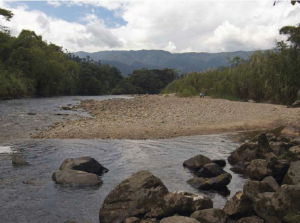The Tsáchila nationality, renowned for its cultural richness, thrives in the communities of Santo Domingo canton. With their settlements spread across seven distinct communities – Poste, Peripa, Chiguilpe, Otongo Mapalí, Los Naranjos, Colorados del Búa, and Cóngoma – the Tsáchila ethnic group epitomises the vibrant cultural fabric of the region. The name Tsáchila, meaning “true people”, aptly reflects the identity of these indigenous groups residing in this area. At the heart of Tsáchila culture lies their unique language, Tsafiqui (true word), which holds a significant place in Ecuador’s linguistic heritage.
Distinct Attire: A Blend of Tradition and Identity
The clothing worn by the Tsáchila community members showcases distinctive characteristics, bearing immense cultural significance. Men and women wear garments with unique styles, reflective of their individual identities. Women wear multicoloured skirts called tunan, symbolising the vibrant hues of a rainbow. Ribbons of various colours adorn their hair, and colourful necklaces made from locally sourced seeds complete their ensemble. Conversely, men wear black and white skirts known as mampé tsampá, secured with a red cloth. They also decorate their hair with red paint, further accentuating their distinct appearance.
Preservation of Territorial Space and Sustainable Livelihoods
For the Tsáchila culture, the conservation of their territorial space holds paramount importance. They view it as the foundation of their family and community nucleus, where they coexist harmoniously with numerous plant and animal species. Fishing, agriculture, and tourism form the pillars of their livelihoods. Embracing self-sufficiency, they cultivate their food while harnessing the power of plants in their shamanic rituals.
Vibrant Festivities: Showcasing Culture and Tradition
Santo Domingo de los Tsáchilas buzzes with an extensive array of festivities and celebrations. These events encompass cultural exhibitions, gastronomic delights, extreme sports competitions, and mesmerising concerts. Kasama, the sole festival observed by the Tsáchila ethnic group, holds deep cultural significance. In the Tsafiqui language, “Kasa” means new, and “ma” signifies a day, symbolising the dawn of a fresh day or new year. This vibrant celebration, coinciding with the Saturday of Glory in the Catholic calendar, goes beyond the Western concept of a new year. In the past, it served as a platform for courtship, accompanied by music, drinks, and lively contests. Today, Kasama features dance, theatre, music, indigenous competitions, and showcases of hunting and fishing skills, embracing the diverse traditions of the Tsáchila community.
Handcrafted Treasures: Symbolism in Decoration
The Tsáchila nationality boasts a repertoire of exquisite handcrafted elements that serve as decorative items. These creations often incorporate the seeds of San Pedro, believed to be spiritual protectors for the wearers. Each piece carries profound symbolism and echoes the deep-rooted beliefs of the Tsáchila people.
Cultural Guardians: Shamans and Customs
In every Tsáchila community, shamans play a vital role. These revered individuals harness the healing properties of herbs to restore wellbeing among their people. Aspiring shamans typically hail from lineages closely connected to the great Pone, serving as healers and keepers of traditional wisdom.
Sustenance from Land and Water
The Tsáchila people embrace a way of life deeply intertwined with the land and water. Their sustenance is derived from a harmonious blend of agriculture, hunting, and fishing practices. Plantains form the cornerstone of their diet, serving as a staple crop. In addition to plantains, they cultivate cassava, yams, cacao, peppers, corn, rice, and various other crops, showcasing their agricultural prowess. The Tsáchila community also engages in hunting and rearing domestic animals, which further supplements their food sources. When it comes to fishing, they employ traditional techniques and often utilise poisons extracted from forest plants, exhibiting their profound understanding of the ecosystem.
Distinctive Architecture: A Glimpse into Tsáchila Homes
The Tsáchila homes boast distinctive architectural features that provide insight into their way of life. The predominant construction style is characterised by gabled roofs, with rectangular structures being the norm. Typically, the dimensions of these houses measure around 13 metres in length, 7 metres in width, and 5 metres in height.
A notable aspect of Tsáchila dwellings is the use of round pillars, known as tuctangas, to support the framework. These pillars are crafted from the resilient and unyielding bisolá palm tree, reflecting the resourcefulness and craftsmanship of the Tsáchila people. Among the various types of houses, the cumbrero or yaburé stands out as a common dwelling. Covered with leaves and supported by the sills, this structure represents an integral part of Tsáchila architecture. Notably, these houses do not feature windows and are divided into two equal-sized compartments.
Culinary Traditions and Customs
The Tsáchila diet draws heavily from their agricultural practices, hunting expeditions, and fishing ventures. A popular daily dish is the “pandado”, consisting of one or two small fish accompanied by a piece of banana, all wrapped within a bijao leaf. Additionally, the Tsáchila people relish the chontaduro, a wild fruit rich in floury sustenance. After returning from hunting trips, the men preserve smoked meats by wrapping them in banana leaves and storing them alongside the smoke for two weeks, ensuring their sustenance for an extended period.
For tourists seeking to tantalise their taste buds, a journey through the Tsáchila region offers a delightful culinary experience. One such delicacy is the “mayon-ayampaco” made from fish, such as guaña and tilapia, prepared using traditional cooking methods. Another culinary highlight is the “bolón de verde”, crafted from green plantains. These delectable treats showcase the region’s rich gastronomic heritage, inviting visitors to indulge in the flavours of the Tsáchila culture.
Preserving Heritage Amidst a Changing World
As primarily an agricultural community, the Tsáchila people are unwavering in their commitment to preserving their unique culture and heritage, inspiring future generations and fostering pride. Embarking on a visit to the Tsáchila communities unveils a fascinating tapestry of unique experiences, diverse traditions, exquisite handicrafts, and tantalising gastronomy. Tourists can witness the profound connection between the Tsáchila people and their ancestral customs through short tours showcasing the benefits of medicinal plants.

Men’s clothing


Kasama




